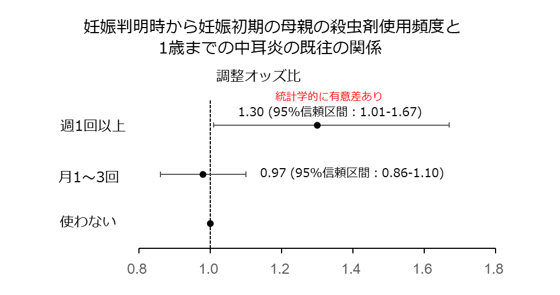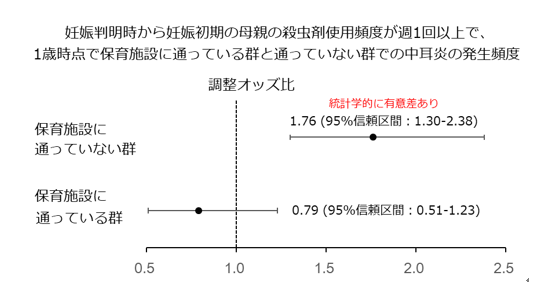About the Corporation
Association between pesticide use by pregnant women and risk of otitis media in children up to one year of age
A research team from Department of Pediatrics and Eco-Children Survey Hyogo Unit Center at Hyogo Medical University (Nishinomiya, Hyogo Prefecture; President: Koichi Noguchi) analyzed the relationship between the frequency of pesticide use by pregnant women and the likelihood of their children suffering from otitis media within the first year of life, based on data from approximately 100,000 parent-child pairs from the National Survey on Children's Health and the Environment (hereinafter referred to as the "Eco-Children Survey").
The results showed that when pregnant women used insecticides at work at least once a week during early pregnancy, there was an association with an increased frequency of their children suffering from otitis media by the age of one. These results suggest a relationship between maternal exposure to insecticides and the incidence of otitis media in newborns.
However, there are limitations to this study, such as the fact that the type and amount of pesticide used is unclear, that the analysis was based on questionnaire responses and did not involve analysis of pesticide components in biological samples from pregnant women, and that it is unclear whether other factors that affect the incidence of otitis media are involved.
*The contents of this study are the opinions of the authors and do not necessarily represent the views of the Ministry of the Environment or the National Institute for Environmental Studies.
The results of this research were published in Scientific Reports, an academic journal in the field of natural sciences published by Nature Research, on January 25, 2022 (7:00 p.m. Japan time).
[Paper publication information]
・Magazines featured
"Scientific Reports" DOI: 10.1038/s41598-022-05433-2
・Thesis title
"Association between maternal insecticide use and otitis media in one-year-old children in the Japan Environment and Children's Study"
·author
Takeshi Utsunomiya※1, Naoko Taniguchi※1,2, Yohei Taniguchi※1, Tetsuro Fujino※1, Yasuhiko Tanaka※1,2, Hideki Hasunuma※2,3, Masumi Okuda※1, Masayuki Shima※2,3, Yasuhiro Takeshima※1,2, and the Japan Environment and Children's Study Group※4
*1 Tsuyoshi Utsunomiya, Naoko Taniguchi, Yohei Taniguchi, Tetsuro Fujino, Yasuhiko Tanaka, Masumi Okuda, Yasuhiro Takeshima: Department of Pediatrics Hyogo Medical University College of Medicine
*2 Naoko Taniguchi, Yasuhiko Tanaka, Hideki Hasunuma, Masayuki Shima: Eco-Children Survey Hyogo Unit Center
*3 Hideki Hasunuma, Masayuki Shima: Department of Public Health, Hyogo Medical University
*4 Group: Core Center Director, Medical Support Center Representative, and each Unit Center Director
Key points of the announcement
-Using data from the Eco-Children Survey, we investigated the relationship between the frequency of pesticide use by pregnant women and the incidence of otitis media in their children by the age of one.
- When pregnant women used insecticides at work for more than half a day at least once a week from the time they found out they were pregnant through the early stages of pregnancy, it was found to be associated with an increased incidence of otitis media in their children by the age of one.
When looking at whether the child was attending childcare at the time the child turned one year old, only in the group that did not attend childcare, it was found that if pregnant women used insecticides at work for more than half a day at least once a week from the time their pregnancy was discovered during the early stages of pregnancy, this was associated with an increased frequency of their child suffering from otitis media by the time the child turned one year old.
On the other hand, when pregnant women used insecticides at work for more than half a day at least once a week from the time they found out they were pregnant until the second trimester, there was no association between this and an increased incidence of otitis media in their children by the age of one.
Research Background
The National Survey on Children's Health and the Environment (hereafter referred to as the "ECO-CHILD Study") is a large-scale, long-term birth cohort study launched by the Ministry of the Environment in 2010 targeting approximately 100,000 parent-child pairs nationwide to clarify the impact of chemical exposure from the fetal to childhood period on children's health. Biological samples such as umbilical cord blood, blood, urine, breast milk, and milk teeth are collected, preserved, and analyzed, and follow-up surveys are conducted to clarify the relationship between children's health and environmental factors such as chemicals.
The Eco-Children Survey is being carried out in collaboration with the Ministry of the Environment and related organizations, with a Core Center at the National Institute for Environmental Studies as the central research institution, a Medical Support Center at the National Center for Child Health and Development to provide medical support, and Unit Centers as regional survey bases at 15 universities and other institutions selected through a public application process to conduct surveys in various regions of Japan.
<Background of this research>
Otitis media is a common illness in children and consists of acute otitis media, serous otitis media, and chronic otitis media. The incidence of acute otitis media is said to be approximately 10.8 per 100 people per year, and is caused by bacteria such as Streptococcus pneumoniae and Haemophilus influenzae. Risk factors for otitis media include being a boy, having a family history of recurrent otitis media, exposure to tobacco smoke, having older siblings, and attending childcare facilities. Breastfeeding for the first six months of life is also known to help prevent otitis media.
Pyrethroids and organochlorine compounds are the main components of insecticides, and several studies have examined the effects of maternal exposure on offspring. While some studies have shown a correlation between maternal pyrethroid exposure and children's attention deficit hyperactivity disorder (ADHD) between the ages of 2 and 4, others have found no correlation between maternal pyrethroid metabolite concentrations and children's cognitive scores, and others have shown that maternal exposure to pyrethroid insecticides during pregnancy has a positive effect on children's development. A study examining the relationship between maternal exposure to insecticides during pregnancy and the incidence of otitis media found that exposure to organochlorine compounds was a risk factor for acute otitis media in Inuit pregnant women. In this study, we analyzed whether there was a correlation between children's incidence of otitis media within the first year of life and the frequency of maternal insecticide use during pregnancy.
Research content and results
In this study, data from approximately 100,000 parent-child pairs were enrolled in the Eco-Child Survey, and survey data was collected from early pregnancy until the child's first year of age. Of these, 98,255 parents whose children were liveborn or singletons and provided valid responses to a self-administered questionnaire were used to analyze the relationship between the frequency of pregnant women's use of insecticides from the time pregnancy was discovered through early pregnancy and from the time pregnancy was discovered through mid-pregnancy and the frequency of their children suffering from otitis media by the time their children were one year old.
Logistic regression analysis*2 was used to analyze the data, using covariates*1 such as gender, whether the child was breastfed until six months of age, mother's age, gestational age, birth weight, whether or not there were siblings living with the child at six months of age, whether or not the child attended daycare at one year of age, the mother's history of chronic otitis media, the child's own vaccination history, the mother's and father's smoking history, whether or not the mother was exposed to passive smoking, whether or not the child had undergone fertility treatment, and the mother's occupational classification.Further analysis was performed by stratifying the data by whether or not the child attended daycare, whether or not there were siblings, and the mother's history of chronic otitis media, which are known to be risk factors for otitis media.
The analysis showed no significant difference in the frequency of insecticide use by pregnant women between those whose babies suffered from otitis media by the age of one and those whose babies did not. Logistic regression analysis showed that the group in which pregnant women used insecticides at least once a week during early pregnancy had a 1.30 times higher incidence of otitis media compared to those who did not use insecticides (Reference Figure 1).
Stratified analysis showed that among children not attending childcare facilities, the frequency of otitis media was 1.76 times higher in the group whose pregnant women used insecticides at least once a week during the early stages of pregnancy compared to the group who did not use insecticides. However, when the period of insecticide use was limited to the period from when pregnancy was discovered until the second trimester, no association was observed (Reference Figure 2).
This study has several limitations. First, the use of insecticides by pregnant women was assessed through responses to a questionnaire, and the type and amount of use were not clear. Furthermore, analysis of insecticide components in the biological samples of pregnant women was not performed. It is also possible that respondents were mistaken about the time of insecticide use when answering the questionnaire. Furthermore, there may be unknown confounding factors that affect the incidence of otitis media.
The results of this study showed that pregnant women who used insecticides at work at least once a week for half a day or more during early pregnancy were associated with a higher incidence of otitis media in their children up to one year of age. The association was even stronger in women whose children did not attend childcare facilities.
*1 Covariate: A factor that affects the outcome
*2 Logistic regression analysis: A statistical method for examining the probability of a specific event occurring when multiple factors are related.
Future developments
"We believe it is necessary to clarify the relationship between the type and amount of insecticide used during early pregnancy and the incidence of otitis media in children. Further research is also needed into other factors that affect the incidence of otitis media."
The Eco-Children Survey is expected to continue to shed light on environmental factors, such as chemicals, that affect children's development and health.
Reference diagram

[Reference Figure 1]
Pregnant women who used insecticides at least once a week during early pregnancy were 1.30 times more likely to suffer from otitis media than those who did not use insecticides.

[Reference Figure 2]
The incidence of otitis media in children born to pregnant women who used insecticides at least once a week was 1.76 (top row) in the group that did not attend childcare facilities compared to the group that did not use insecticides, while it was 0.79 (bottom row) in the group that did attend childcare facilities. The frequency of otitis media was higher only in the group that did not attend childcare facilities.
Research inquiries
Hyogo Medical University Eco-Child Research Hyogo Unit Center
Director: Masayuki Shima
TEL: 0798-45-6636
E-mail: ecochild@hyo-med.ac.jp
Inquiries regarding this release
Hyogo Medical University Public Relations Division
TEL: 0798-45-6655 (direct)
FAX: 0798-45-6219
Email: kouhou@hyo-med.ac.jp